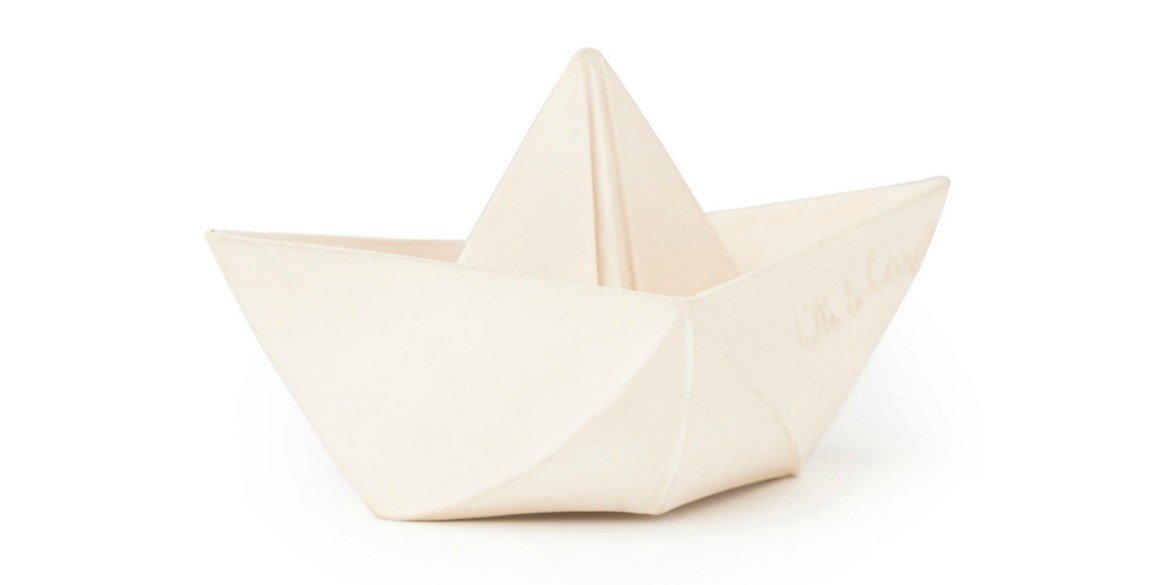An Introduction to Origami
When I was in eighth grade, my middle school embarked on a challenge to fold as many paper cranes as possible. If I remember correctly, it was part of an international campaign to support Japan and help rebuild after the 2011 earthquake and tsunami. We learned how to fold them in art class, and for a couple of weeks, we spent every free period forming little paper birds. This was my first real encounter with origami, and I became hooked. I enjoyed feeling like I was doing something good (I believe the campaign donated a certain amount of money for each crane), and I got a great deal of satisfaction from creating something out of a simple piece of paper. Since then, I’ve kept up origami as a hobby, folding more cranes and countless other shapes.
Shop Oil & Carol Origami Boat Bath Toy here!
Origami as an art form has been around for a long time. Some historians believe paper folding began in China since paper was invented there at the beginning of the second century, according to the New World Encyclopedia (NWE) and PBS. However, the Japanese started using paper in the sixth century, and origami is largely associated with Japan. As the NWE explains, the word 'origami' itself comes from the Japanese words ‘oru’ (fold) and ‘kami’ (paper). Early on, paper was a rare and expensive luxury, so origami served ceremonial and religious purposes for the elite. As time went on, however, paper became more accessible and origami became a popular art form across classes. The crane is one of the most popular models, as this bird symbolizes ‘good health, longevity, truth and fidelity’ in Japanese and other Asian cultures. A Japanese legend promises that anyone who folds 1,000 paper cranes will be granted a wish.
While you might not actually be granted a magical wish, I recommend origami to anyone looking for a new hobby or who could simply use a dose of creativity and calm. Origami is sometimes even used in art therapy or to practice Zen Buddhism! For me, origami is a great creative outlet as well as a therapeutic activity. Not only am I making something with my hands and watching a piece of paper transform into a three-dimensional, visually appealing object, but it forces me to be patient and concentrate. There are so many distractions in the world, so sometimes it’s nice to slow down and focus on carefully folding paper. It’s rewarding to spend a while making weird folds in a piece of paper, see the final outcome start to take shape, and finally end up with something beautiful.
Origami can be a challenge, both because you have to visualize the shape and then manipulate the paper, but also because you have to take everything in stride. If you’re doing origami for the first time, you may encounter some frustration. Paper doesn’t always move precisely how you want it to, and when you’re following instructions it’s sometimes hard to tell exactly what you’re supposed to do. Ultimately, this frustration is a good thing, especially if you sometimes struggle with patience and/or perfectionism. Not every piece will come out perfectly, but you’ll learn to love even the wonky ones. After taking the time to form something with your own hands, you’ll develop an affection for it. You’ll also get better at taking a step back when you get stuck. Sometimes, you might need to set aside a particularly difficult model, but don’t give up. Simply keep practicing and return to it eventually!

Origami is a great creative outlet as well as a therapeutic activity.

Luckily, origami can pretty much be as low-effort or as intense as you want it to be, and you can either buy special products for it or simply cut computer paper to size and look up instructions online, in the form of either diagrams or videos. There are plenty of simple models like the crane, in addition to more complex models that are still traditional, like the lotus. If you want a challenge you can search online for even more complicated creations. Another way to challenge yourself with origami is to aim to fold a large number of pieces, such as 1,000 paper cranes, or something a little more manageable that still requires many iterations. Modular origami is assembled from multiple separate units. Alternatively, you can try cutting your paper down a lot and folding teeny-tiny versions, or using non-traditional materials like pages from a magazine.
Whatever your goal is—to start a fun new hobby, to channel your creative energy, or to find a new mindfulness habit—origami is a great practice to try. Start small, and build up however much you want. Keep the pieces you create to decorate your space or give them to friends and family. You’ll end up with great-looking pieces and reap the calming benefits of the practice. Good luck!
Allison is a rising senior at Hamilton College who loves reading, writing, and animals. She is majoring in Literature and minoring in Psychology, and she plans to go into publishing upon graduation.


Comments